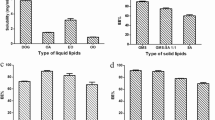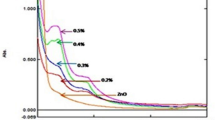Abstract
Diabetic nephropathy (DN) is a significant source of end-stage renal illness all over the world in both developed and developing countries. The aim of the study was to optimize rubiadin-loaded niosomes (RLN) using Box-Behnken design for the management of streptozotocin-nicotinamide (STZ-NA)-induced DN in Wistar rats. The RLN were formulated by a “thin-layer hydration technique.” The optimization of RLN was done by Box-Behnken design; the independent variables were cholesterol (CHOL), Span 80, and methanol, while the dependent factors were the vesicle size, zeta potential, and entrapment efficiency. The optimized formulation was characterized for various biochemical parameters including anti-diabetic activity in Wistar rats. The optimized RLN presented vesicle size of 238 nm, zeta potential −68 mV, and entrapment efficiency 85%. A noteworthy decreased in blood glucose level was detected in STZ-NA-induced DN rats when orally treated with RLN (100 mg/kg/week and 200 mg/kg/week). Oral administration of RLN formulation considerably decreased the levels of urea, uric acid, and creatinine in DN rats. In addition, treatment of DN rats with RLN formulation considerably improves the level of TBARS, GSH, SOD, and CAT. The lipid profile of DN rats was also improved on treatment with RLN formulation. This study revealed that the prepared RLN formulation was successfully optimized by Box-Behnken design and found to be useful for the management of STZ-NA-induced DN in Wistar rats.
Graphical abstract









Similar content being viewed by others
Data availability
The authors confirm that the data findings of this study are available within the article.
References
Ahad A, Raish M, Ahmad A, Al-Jenoobi FI, Al-Mohizea AM. Development and biological evaluation of vesicles containing bile salt of telmisartan for the treatment of diabetic nephropathy. Artif Cells Nanomed Biotechnol. 2018;46:532–9.
Qi C, Mao X, Zhang Z, Wu H. Classification and differential diagnosis of diabetic nephropathy. J Diabetes Res. 2017;2017:8637138.
Karnoosh-Yamchi J, Rahmati-Yamchi M, Akbarzadeh A, Davaran S, Ostad Rahimi AR, Garnoosh K, Bahmani Z, Ashoori M, Mobasseri M. pH sensitive insulin-loaded nanohydrogel increases the effect of oral insulin in diabetic rats. Artif Cells Nanomed Biotechnol. 2017;45:1–5.
Satirapoj B. Nephropathy in diabetes. Adv Exp Med Biol. 2012;771:107–22.
Sun L, Zhang J, Lu X, Zhang L, Zhang Y. Evaluation to the antioxidant activity of total flavonoids extract from persimmon (Diospyros kaki L.) leaves. Food Chem Toxicol. 2011;49:2689–96.
Soldatos G, Cooper ME. Diabetic nephropathy: important pathophysiologic mechanisms. Diabetes Res Clin Pract. 2008;82(Suppl 1):S75–9.
Saeedi P, Petersohn I, Salpea P, Malanda B, Karuranga S, Unwin N, Colagiuri S, Guariguata L, Motala AA, Ogurtsova K, Shaw JE, Bright D, Williams R. Global and regional diabetes prevalence estimates for 2019 and projections for 2030 and 2045: results from the International Diabetes Federation Diabetes Atlas, 9(th) edition. Diabetes Res Clin Pract. 2019;157:107843.
Balaraman AK, Singh J, Dash S, Maity TK. Antihyperglycemic and hypolipidemic effects of Melothria maderaspatana and Coccinia indica in Streptozotocin induced diabetes in rats. Saudi Pharm J. 2010;18:173–8.
Das AK, Kalra S, Tiwaskar M, Bajaj S, Seshadri K, Chowdhury S, Sahay R, Indurkar S, Unnikrishnan AG, Phadke U, Pareek A, Purkait I. Expert group consensus opinion: role of anti-inflammatory agents in the management of type-2 diabetes (T2D). J Assoc Physicians India. 2019;67:65–74.
Comini LR, Montoya SC, Paez PL, Arguello GA, Albesa I, Cabrera JL. Antibacterial activity of anthraquinone derivatives from Heterophyllaea pustulata (Rubiaceae). J Photochem Photobiol B. 2011;102:108–14.
Deoda RS, Kumar D, Bhujbal SS. Gastroprotective Effect of Rubia cordifolia Linn. on Aspirin Plus Pylorus-Ligated Ulcer. Evid Based Complement Alternat Med. 2011;2011:541624.
Patil RA, Jagdale SC, Kasture SB. Antihyperglycemic, antistress and nootropic activity of roots of Rubia cordifolia Linn. Indian J Exp Biol. 2006;44:987–92.
Rani S, Mandave P, Khadke S, Jagtap S, Patil S, Kuvalekar A. Antiglycation, antioxidant and antidiabetic activity of traditional medicinal plant: Rubia Cordifolia Linn. for management of hyperglycemia. Int J Plant Anim Environ Sci. 2013;3:42–49.
Baskar R, Bhakshu LM, Vijaya Bharathi G, Sreenivasa Reddy S, Karuna R, Kesava Reddy G, Saralakumari D. Antihyperglycemic activity of aqueous root extract of Rubia cordifolia. in streptozotocin-induced diabetic Rats. Pharm Biol. 2006;44:475–79.
Joharapurkar AA, Zambad SP, Wanjari MM, Umathe SN. In vivo evaluation of antioxidant activity of alcoholic extract of Rubia Cordifolia Linn. and its influence on ethanol-induced immunosuppression. Indian J Pharmacol. 2003;35:232–36.
Rahman HS, Othman HH, Hammadi NI, Yeap SK, Amin KM, Abdul Samad N, Alitheen NB. Novel drug delivery systems for loading of natural plant extracts and their biomedical applications. Int J Nanomedicine. 2020;15:2439–83.
Bartelds R, Nematollahi MH, Pols T, Stuart MCA, Pardakhty A, Asadikaram G, Poolman B. Niosomes, an alternative for liposomal delivery. PLoS One. 2018;13:e0194179.
Marianecci C, Rinaldi F, Mastriota M, Pieretti S, Trapasso E, Paolino D, Carafa M. Anti-inflammatory activity of novel ammonium glycyrrhizinate/niosomes delivery system: human and murine models. J Control Release. 2012;164:17–25.
Ahad A, Raish M, Al-Jenoobi FI, Al-Mohizea AM. Sorbitane monostearate and cholesterol based niosomes for oral delivery of telmisartan. Curr Drug Deliv. 2018;15:260–6.
Ahad A, Raish M, Ahmad A, Al-Jenoobi FI, Al-Mohizea AM. Eprosartan mesylate loaded bilosomes as potential nano-carriers against diabetic nephropathy in streptozotocin-induced diabetic rats. Eur J Pharm Sci. 2018;111:409–17.
Mariselvam R, Ranjitsingh AJA, Usha Raja Nanthini A. Preparation and characterization of silver nanoparticles using Rubia cordifolia plant root extract and their microbial properties. Int J of Adv Res. 2013;1:56–61.
Kishore L, Kaur N, Singh R. Nephroprotective effect of Paeonia emodi via inhibition of advanced glycation end products and oxidative stress in streptozotocin-nicotinamide induced diabetic nephropathy. J Food Drug Anal. 2017;25:576–88.
Ohkawa H, Ohishi N, Yagi K. Assay for lipid peroxides in animal tissues by thiobarbituric acid reaction. Anal Biochem. 1979;95:351–8.
Griffith OW. Determination of glutathione and glutathione disulfide using glutathione reductase and 2-vinylpyridine. Anal Biochem. 1980;106:207–12.
Sensi M, Pricci F, Pugliese G, De Rossi MG, Petrucci AF, Cristina A, Morano S, Pozzessere G, Valle E, Andreani D, et al. Role of advanced glycation end-products (AGE) in late diabetic complications. Diabetes Res Clin Pract. 1995;28:9–17.
Kagawa M, Fujimoto Z, Momma M, Takase K, Mizuno H. Crystal structure of Bacillus subtilis alpha-amylase in complex with acarbose. J Bacteriol. 2003;185:6981–4.
Ajazuddin SS. Applications of novel drug delivery system for herbal formulations. Fitoterapia. 2010;81:680–9.
Bharali DJ, Siddiqui IA, Adhami VM, Chamcheu JC, Aldahmash AM, Mukhtar H, Mousa SA. Nanoparticle delivery of natural products in the prevention and treatment of cancers: current status and future prospects. Cancers (Basel). 2011;3:4024–45.
Wang S, Su R, Nie S, Sun M, Zhang J, Wu D, Moustaid-Moussa N. Application of nanotechnology in improving bioavailability and bioactivity of diet-derived phytochemicals. J Nutr Biochem. 2014;25:363–76.
Shah A, Boldhane S, Pawar A, Bothiraja C. Advanced development of a non-ionic surfactant and cholesterol material based niosomal gel formulation for the topical delivery of anti-acne drugs. Mater Adv. 2020;1:1763–74.
Siddiqui IA, Sanna V. Impact of nanotechnology on the delivery of natural products for cancer prevention and therapy. Mol Nutr Food Res. 2016;60:1330–41.
Kamble B, Talreja S, Gupta A, Patil D, Pathak D, Moothedath I, Duraiswamy B. Development and biological evaluation of Gymnema sylvestre extract-loaded nonionic surfactant-based niosomes. Nanomedicine (Lond). 2013;8:1295–305.
Lim A. Diabetic nephropathy - complications and treatment. Int J Nephrol Renovasc Dis. 2014;7:361–81.
Sun GD, Li CY, Cui WP, Guo QY, Dong CQ, Zou HB, Liu SJ, Dong WP, Miao LN. Review of herbal traditional Chinese medicine for the treatment of diabetic nephropathy. J Diabetes Res. 2016;2016:5749857.
Choudhury H, Pandey M, Hua CK, Mun CS, Jing JK, Kong L, Ern LY, Ashraf NA, Kit SW, Yee TS, Pichika MR, Gorain B, Kesharwani P. An update on natural compounds in the remedy of diabetes mellitus: a systematic review. J Tradit Complement Med. 2018;8:361–76.
Kooti W, Farokhipour M, Asadzadeh Z, Ashtary-Larky D, Asadi-Samani M. The role of medicinal plants in the treatment of diabetes: a systematic review. Electron Physician. 2016;8:1832–42.
Tripathi YB, Sharma M, Manickam M. Rubiadin, a new antioxidant from Rubia cordifolia. Indian J Biochem Biophys. 1997;34:302–6.
Patil R, Mohan M, Kasture V, Kastur S. Rubia cordifolia: a review. Orient Pharm Exp Med. 2009;9:1–13. https://doi.org/10.3742/OPEM.2009.9.1.001.
Shi J, Ren X, Wang J, Wei X, Liu B, Jia T. Effects of the salt-processing method on the pharmacokinetics and tissue distribution of orally administered Morinda officinalis How. Extract J Anal Methods Chem. 2020;2020:5754183.
Somani RS, Jain KS, Singhai AK. Hypoglycaemic activity of roots of Rubia cordifolia in normal and diabetic rats. Pharmacologyonline. 2007;1:162–9.
Cheng D, Liang B, Li Y. Antihyperglycemic effect of Ginkgo biloba extract in streptozotocin-induced diabetes in rats. Biomed Res Int. 2013;2013:162724.
Srinivasan K, Ramarao P. Animal models in type 2 diabetes research: an overview. Indian J Med Res. 2007;125:451–72.
Singh R, Kaur N, Kishore L, Gupta GK. Management of diabetic complications: a chemical constituents based approach. J Ethnopharmacol. 2013;150:51–70.
Almdal TP, Vilstrup H. Strict insulin therapy normalises organ nitrogen contents and the capacity of urea nitrogen synthesis in experimental diabetes in rats. Diabetologia. 1988;31:114–8.
Soltani N, Keshavarz M, Dehpour AR. Effect of oral magnesium sulfate administration on blood pressure and lipid profile in streptozocin diabetic rat. Eur J Pharmacol. 2007;560:201–5.
Okosun IS, Liao Y, Rotimi CN, Choi S, Cooper RS. Predictive values of waist circumference for dyslipidemia, type 2 diabetes and hypertension in overweight White, Black, and Hispanic American adults. J Clin Epidemiol. 2000;53:401–8.
Baron AD. Postprandial hyperglycaemia and alpha-glucosidase inhibitors. Diabetes Res Clin Pract. 1998;40(Suppl):S51–5.
Chelladurai GRM, Chinnachamy C. Alpha amylase and Alpha glucosidase inhibitory effects of aqueous stem extract of Salacia oblonga and its GC-MS analysis. Braz J Pharm Sci. 2018;54:e17151. https://doi.org/10.1590/s2175-97902018000117151.
Kajaria D, Ranjana, Tripathi J, Tripathi YB, Tiwari S. In-vitro alpha amylase and glycosidase inhibitory effect of ethanolic extract of antiasthmatic drug - Shirishadi. J Adv Pharm Technol Res. 2013;4:206–9.
Derosa G, Maffioli P. alpha-Glucosidase inhibitors and their use in clinical practice. Arch Med Sci. 2012;8:899–906.
Telagari M, Hullatti K. In-vitro alpha-amylase and alpha-glucosidase inhibitory activity of Adiantum caudatum Linn. and Celosia argentea Linn. extracts and fractions. Indian J Pharmacol. 2015;47:425–9.
Kazeem MI, Adamson JO, Ogunwande IA. Modes of inhibition of alpha-amylase and alpha-glucosidase by aqueous extract of Morinda lucida Benth leaf. Biomed Res Int. 2013;2013:527570.
Uribarri J, del Castillo MD, de la Maza MP, Filip R, Gugliucci A, Luevano-Contreras C, Macias-Cervantes MH, Markowicz Bastos DH, Medrano A, Menini T, Portero-Otin M, Rojas A, Sampaio GR, Wrobel K, Garay-Sevilla ME. Dietary advanced glycation end products and their role in health and disease. Adv Nutr. 2015;6:461–73.
Funding
The author (Tinku) received financial support from Hamdard National Foundation (HNF), Jamia Hamdard New Delhi, India.
Author information
Authors and Affiliations
Corresponding author
Ethics declarations
Ethical approval
The animal study protocol was approved, and experiments were conducted as per the “Jamia Hamdard Animal Ethics Committee” (approval number 1493, dated 22-01-2019) and “CPCSEA, Government of India.”
Conflict of interest
The authors declare no competing interests.
Additional information
Publisher's Note
Springer Nature remains neutral with regard to jurisdictional claims in published maps and institutional affiliations.
Supplementary Information
Below is the link to the electronic supplementary material.
Rights and permissions
About this article
Cite this article
Tinku, Mujeeb, M., Ahad, A. et al. Ameliorative effect of rubiadin-loaded nanocarriers in STZ-NA-induced diabetic nephropathy in rats: formulation optimization, molecular docking, and in vivo biological evaluation. Drug Deliv. and Transl. Res. 12, 615–628 (2022). https://doi.org/10.1007/s13346-021-00971-0
Accepted:
Published:
Issue Date:
DOI: https://doi.org/10.1007/s13346-021-00971-0




